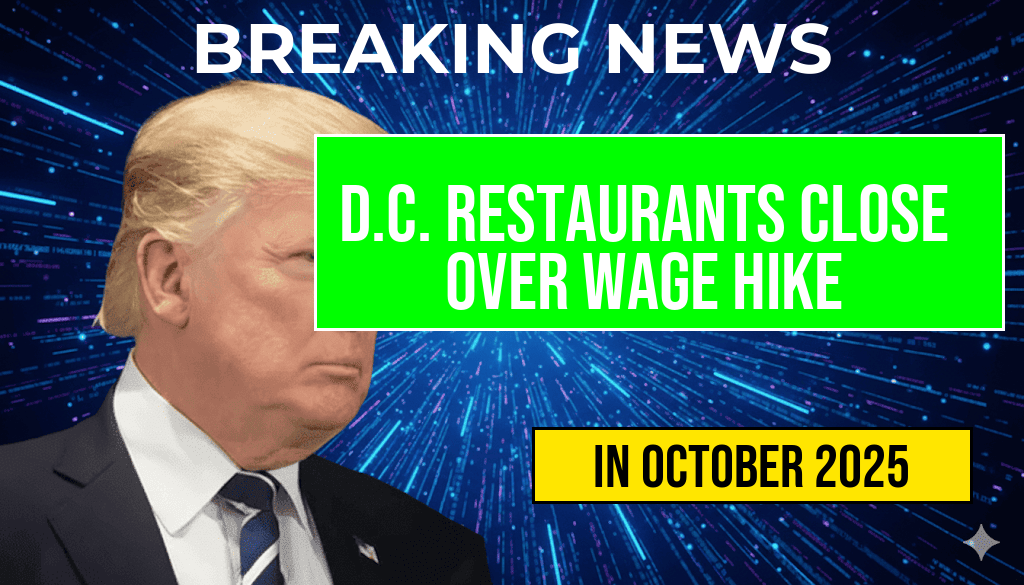DC Restaurants Pass $20 Surcharge as Rising Wage Costs Shift Burden to Diners
Many restaurants across Washington, D.C., are now adding surcharges exceeding $20 per check, reflecting a significant shift in how establishments are managing rising labor costs. The surge in wage regulations, including increased minimum wages and mandated benefits, has prompted many eateries to implement additional fees to offset higher payroll expenses. This trend marks a notable departure from traditional tipping and menu price increases, raising concerns among consumers about transparency and affordability. With the average check at some popular spots now bearing these substantial surcharges, diners are facing the reality that paying for their meals involves more than just the listed menu prices. Industry insiders warn that if wage pressures persist, such surcharges could become standard practice, reshaping the dining landscape in the nation’s capital.
Wage Regulations and Their Impact on Restaurant Costs
Over the past two years, Washington, D.C., has enacted a series of wage policies aimed at improving earnings for hospitality workers. The city’s minimum wage has risen steadily, reaching $16.50 per hour in 2023, with plans to further increase in the coming years. Additionally, mandates for paid sick leave, health benefits, and tip-sharing arrangements have amplified operational costs for restaurant owners. These policies, while praised for improving worker welfare, have placed financial pressure on establishments already grappling with inflation, supply chain disruptions, and labor shortages.
According to data from the D.C. Department of Employment Services, wages account for a significant portion of restaurant operating expenses. When combined with rising rent and utility costs, the cumulative financial burden has prompted some businesses to seek alternative revenue streams, including service surcharges and fees. While menu price hikes remain common, they often fail to fully compensate for the increased labor costs, leading many owners to implement per-check surcharges as a more transparent way to recover expenses.
Extent of the Surcharges and Consumer Response
| Type of Establishment | Average Surcharge per Check | Range of Surcharges |
|---|---|---|
| Fine Dining | $22.50 | $20–$25 |
| Casual Restaurants | $18.75 | $15–$20 |
| Fast Casual | $12.00 | $10–$15 |
Major establishments in the district have begun prominently displaying these surcharges, which often appear as line items on bills alongside taxes and gratuities. Some restaurants have introduced fixed fees, such as a $20 or higher surcharge, especially for larger parties or during peak hours. While the practice aims to ensure fair compensation for staff, it has sparked mixed reactions among consumers. Many patrons express frustration over unexpected costs, fearing that transparency is compromised or that the surcharges could be used as a substitute for fair menu pricing.
Industry Perspectives and Future Outlook
Restaurant industry advocates argue that surcharges are a necessary response to the evolving wage landscape, allowing businesses to maintain profitability without abruptly raising menu prices. Forbes reports that some operators see these surcharges as a compromise that balances fair wages with economic sustainability. However, critics contend that such fees can erode consumer trust and diminish the overall dining experience.
Matthew Williams, owner of a mid-range bistro in downtown D.C., remarked, “We’re simply trying to keep our staff paid well while remaining viable. The surcharge is transparent, but I worry it might turn away some customers if they’re not prepared for it.” Meanwhile, consumer advocacy groups warn that unchecked surcharge practices could lead to a more complicated billing process and potential price gouging.
Legal and Regulatory Considerations
Washington, D.C., law requires that all surcharges be clearly disclosed to consumers before billing, with detailed explanations provided on menus or receipts. The city’s Office of Consumer Protection monitors compliance and investigates complaints related to undisclosed or misleading fees. While most restaurants adhere to these rules, enforcement remains a challenge as surcharges become more widespread.
As the restaurant industry adapts to these increased labor costs, the debate over surcharge transparency and fairness is likely to intensify. Some policymakers are considering legislation to standardize surcharge disclosures, aiming to protect consumers from unexpected expenses while allowing businesses to recover operational costs legitimately.
For diners, understanding that wage regulations are influencing menu charges is crucial, but they also have the right to demand clarity. As surcharges persist and grow, transparency will be key to maintaining trust between restaurants and their patrons.
Frequently Asked Questions
What are the main reasons for the increase in dining surcharges in DC?
The primary reason for the increased dining surcharges is the implementation of new wage regulations that have raised labor costs for restaurants. These regulations aim to improve worker pay, but they have resulted in additional expenses that are often passed on to consumers.
How much are the typical surcharges now added to restaurant checks in DC?
Many restaurants in Washington, DC, are adding surcharges exceeding $20 per check. This increase reflects the rising costs associated with complying with wage regulations.
Are these surcharges mandatory for all restaurants in DC?
No, restaurant surcharges are not mandated by law but are implemented voluntarily by establishments to offset higher operating costs. It is advisable for consumers to check the menu or bill for any applicable surcharges.
How are consumers affected by these increased surcharges?
Consumers are experiencing higher costs when dining out, as surcharges add to the total check. This can impact spending habits and overall restaurant affordability in the city.
What can restaurants do to manage the impact of increased wage costs?
Restaurants may consider implementing surcharges strategically, adjusting menu prices, or improving operational efficiency to offset rising wage expenses while maintaining customer satisfaction.










